1993 BUICK LESABRE tow
[x] Cancel search: towPage 37 of 324

threshold level. When impacting straight into a wall that
does
not move or deform, the threshold level for most
GM vehicles is between 9 and 14 mph. However, this
velocity threshold depends
on the vehicle design and
may be several miles-per-hour faster or slower.
In
addition, this threshold velocity will be considerably
higher if the vehicle strikes an object such as a parked
car which will move and deform on impact. The air bag
is also not designed to inflate in rollovers, side impacts,
or rear impacts where the inflation would provide
no
occupant protection benefit.
In any particular crash, the determination of whether the
air bag should have inflated cannot be based solely
on
the level of damage on the vehicle(s). Inflation is
determined by the angle of the impact and the vehicle’s
deceleration,
of which vehicle damage is only one
indication. Repair cost is not a good indicator of
whether an air bag should have deployed.
What makes an air bag inflate?
In a frontal impact of sufficient severity, sensors
strategically located on the vehicle detect that the
vehicle is suddenly stopping as a result of
a crash. These
sensors complete an electrical circuit, triggering a
chemical reaction of the sodium azide sealed in the
inflator. The reaction produces nitrogen gas, which
inflates the cloth bag. The inflator, cloth bag, and related hardware
are all part
of the air bag inflator module
packed inside the steering wheel.
How does an air bag restrain?
In moderate to severe frontal or near-frontal collisions,
even belted occupants can contact the steering wheel.
The air bag supplements the protection provided by
safety belts. Air bags distribute the force of the impact
more evenly over the occupant’s upper body, stopping
the occupant more gradually. But air bags would not
provide protection in many types
of collisions, including
rollovers and rear and side impacts, primarily because
an occupant’s motion is not toward the air bag. Air bags
should never be regarded as anything more than a
supplement to safety belt protection in moderate to
severe frontal and near-frontal collisions.
What will you see after an air bag inflation?
After the air bag has inflated, it will then quickly
deflate. This occurs
so quickly that some people may
not even realize that the air bag inflated. The air bag will
not impede the driver’s vision or ability to steer the
vehicle, nor will it hinder the occupants from exiting the
vehicle. There will be small amounts
of smoke coming
from vents in the deflated air bag. Some components
of
the air bag module in the steering wheel hub may be hot
for a short time, but the portion
of the bag that comes
into contact with you will
not be hot to the touch. The
35
Page 56 of 324
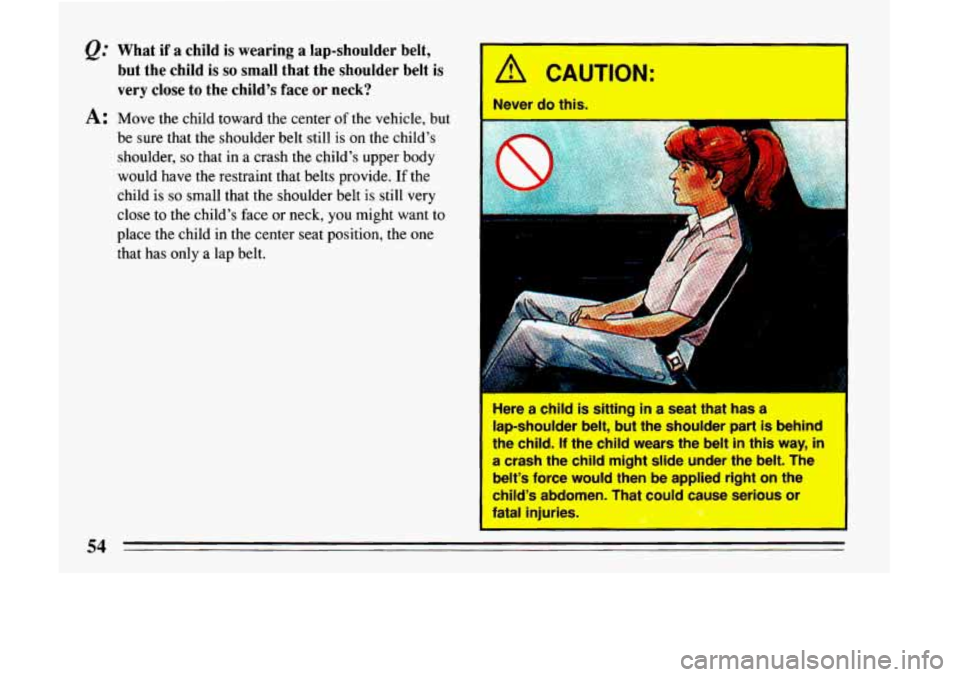
Q." What if a child is wearing a lap-shoulder belt, but the child
is so small that the shoulder belt is
very close to the child's face or neck?
A: Move the child toward the center of the vehicle, but
be sure that the shoulder belt still is on the child's
shoulder,
so that in a crash the child's upper body
would have the restraint that belts provide.
If the
child is
so small that the shoulder belt is still very
close to the child's
face or neck, you might want to
place the child in the center seat position, the one
that has only a lap belt.
A CAUTION:
Never do this.
I"
I
I Here a child is sitting in a seat that has a
lapshoulder belt, but the shoulder part is behind
the child. If the child wears the beltin this way, in
a crash the child might slide under the belt. The
belt's force would then
be applied right on the
-Lsld's abdomen. That dould cause serious or
I laral injuries. 0 0
54
Page 71 of 324

Ignition Key Positions
I
Your square-headed key operates your ignition lock. This
lock gives you five different positions. Before
you
put the key in, your ignition will be in the “Lock”
position. This position locks your ignition, steering
wheel and transaxle. It’s a theft deterrent feature.
The other positions let you perform these functions:
ACC: Accessory lets you use things like the radio and
the windshield wipers when the engine is
off. To get into
“Acc”, push in the key and turn it toward
you. Your
steering wheel will remain locked, just as it was before
you inserted the key.
69
Page 75 of 324
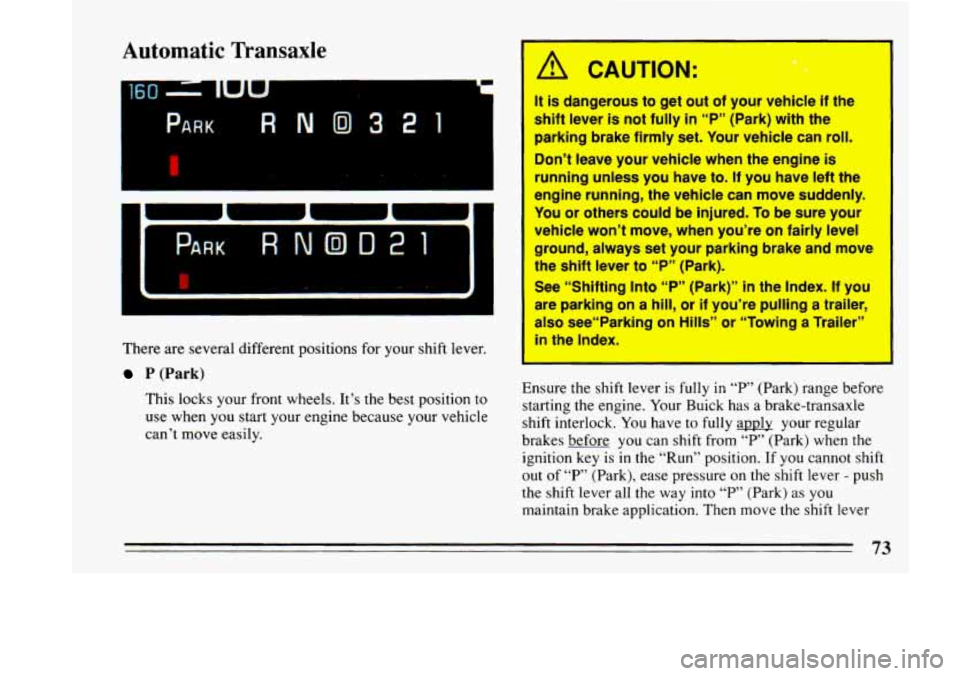
PARK RNO321
Automatic Transaxle
r
There are several different positions for your shift lever.
P (Park)
This locks your front wheels. It’s the best position to
use when you start your engine because your vehicle
can’t move easily.
A CAUTION: .
a -II
It is dangerous to get out of your vehicle If the
shift [ever is not fully in “P” (Park) with the
parking
brake firmly set. Your vehicle can roll.
Don’t leave your vehicle when ihe engine is
running unless you hsve to. If you have left the
engine
running, the vehicle can move suddenly.
You or others could be Injured. To be sure your
vehicle won’t move, when you’re on fairly level
ground, always set your parking brake and move
the shift lever to V“ (Park).
See “Shifting Into “P” (Park)” in the Index. If you
arb parkfng on a hill, or if you’re pulling a trailer,
also see“Parking on Hills” or “Towing a Trailer”
in’ the Index.
- i
Ensure the shift lever is fully in “F‘” (Park) range before
starting the engine. Your Buick has a brake-transaxle
shift interlock.
You have to fully apply your regular
brakes before
you can shift from “P” (Park) when the
ignition key is
in the “Run” position. If you cannot shift
out of “P” (Park), ease pressure on the shift lever - push
the shift lever all
the way into “P” (Park) as you
maintain brake application. Then move the shift lever
73
Page 76 of 324

into the gear you wish. See “Shifting Out of ‘P’ (Park)”
in this part.
R (Reverse)
Use this gear to back up.
Shifting to “R” (Reverse) while your vehicle iz
ng forward could damage your transaxle
only after your vehicle is stopped
To rock your vehicle back and forth to get out of snow,
ice or
sand without damaging your transaxle, see “If
You’re Stuck: In Sand, Mud, Ice
or Snow” in the Index.
N (Neutral)
In this position, your engine doesn’t connect with the
wheels.
To restart when you’re already moving, use
“N” (Neutral) only. Also, use “N” when your vehicle
is being towed.
~ A CAUTION:
Shifting out of “P” (Park) or “N” (Neutral) while .
your engine is “racing” (running at high speed)
is dangerous. Unless your foot-is firmly on the
brake pedal, your.vehicle
could move very ~
rapidJy. You could lose control and hit people or
objects. Don’t shift out of “P” (Park) or “N”
(Neutral) while your engine is racing. Q
Damage to yo-.- transaxle caused by shifting aut I
of “P” (Park) or “N” (Neutral) with the engine
racing isn’t covered by your warranty.
I
@ Automatic Overdrive
This position is for normal driving.
If you need more
power for passing, and you’re:
- Going less than about 35 mph (56 km/h), push
your accelerator pedal about halfway down.
74
Page 77 of 324
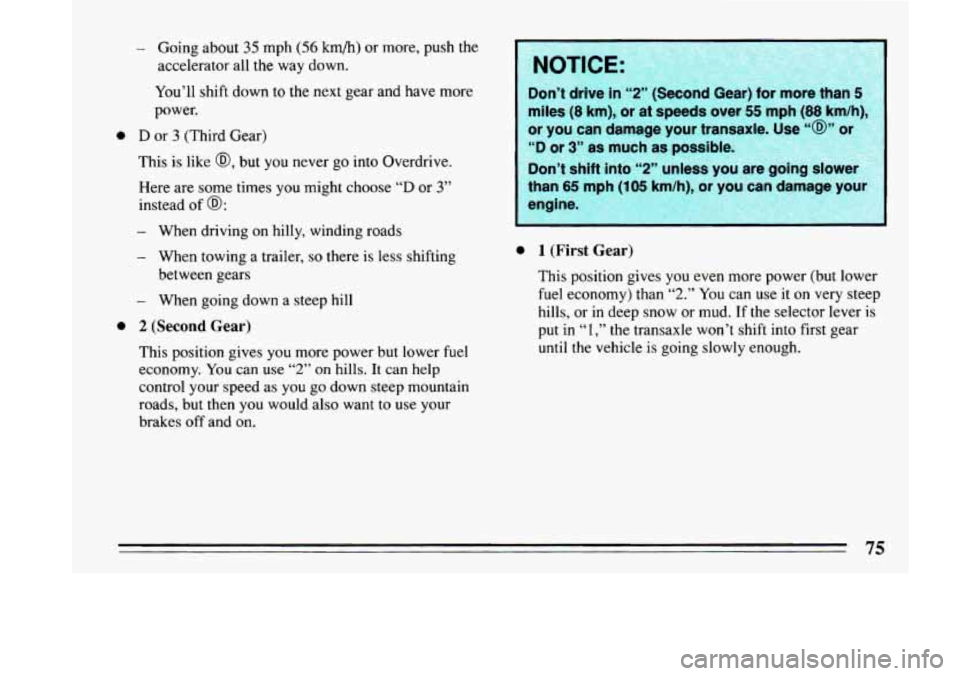
- Going about 35 mph (56 km/h) or more, push the
accelerator all the way down.
You’ll shift down to the next gear and have more
power.
0 D or 3 (Third Gear)
This is like
@, but you never go into Overdrive.
Here are some times you might choose
“D or 3”
instead of @:
- When driving on hilly, winding roads
- When towing a trailer, so there is less shifting
between gears
- When going down a steep hill
0 2 (Second Gear)
This position gives you more power but lower fuel
economy.
You can use “2” on hills. It can help
control your speed as you go down steep mountain
roads, but then you would also want to use your
brakes off and on.
NOTICE:
Don’t drive in “2” (S
or you can damage your trans
“D or 3” as much as possible.
e 1 (First Gear)
This position gives you even more power (but lower
fuel economy) than
“2.” You can use it on very steep
hills,
or in deep snow or mud. If the selector lever is
put in “1,” the transaxle won’t shift into first gear
until the vehicle is going slowly enough.
75
Page 79 of 324
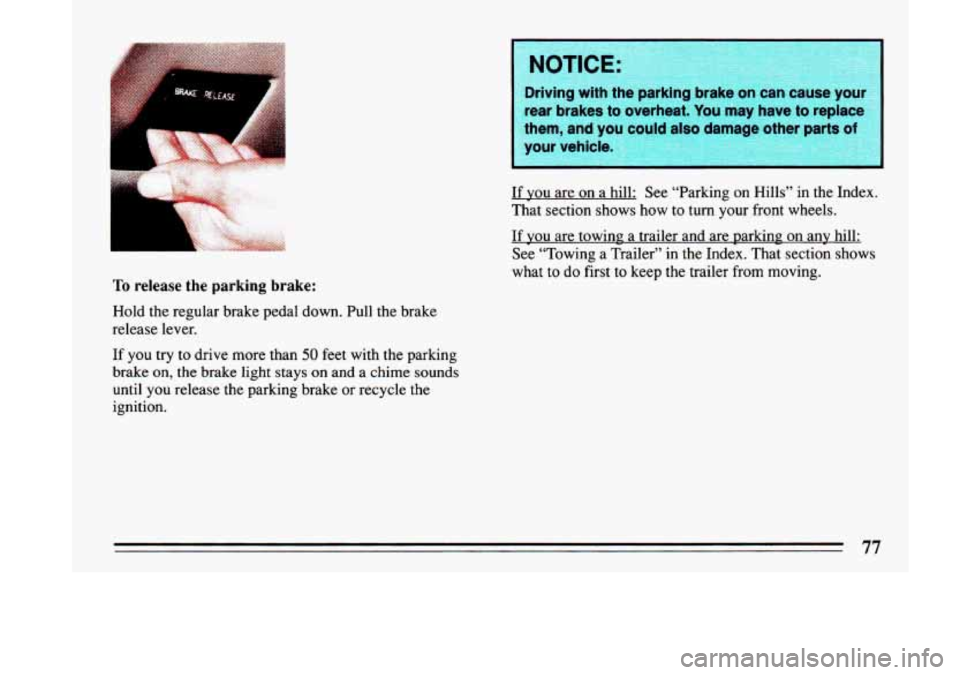
1
To release the parking brake:
Hold the regular brake pedal down. Pull the brake
release lever.
If you try to drive more than
50 feet with the parking
brake
on, the brake light stays on and a chime sounds
until you release the parking brake or recycle the
ignition.
NOTICE
Driving with t
I
rear brakes to overheat. You may have to replace
them,
and you could also damage other parts
If you are on a hill: See “Parking on Hills” in the Index.
That section shows how to turn your front wheels.
If you are towing a trailer and are parking on any hill:
See “Towing a Trailer” in the Index. That section shows
what
to do first to keep the trailer from moving.
77
Page 80 of 324
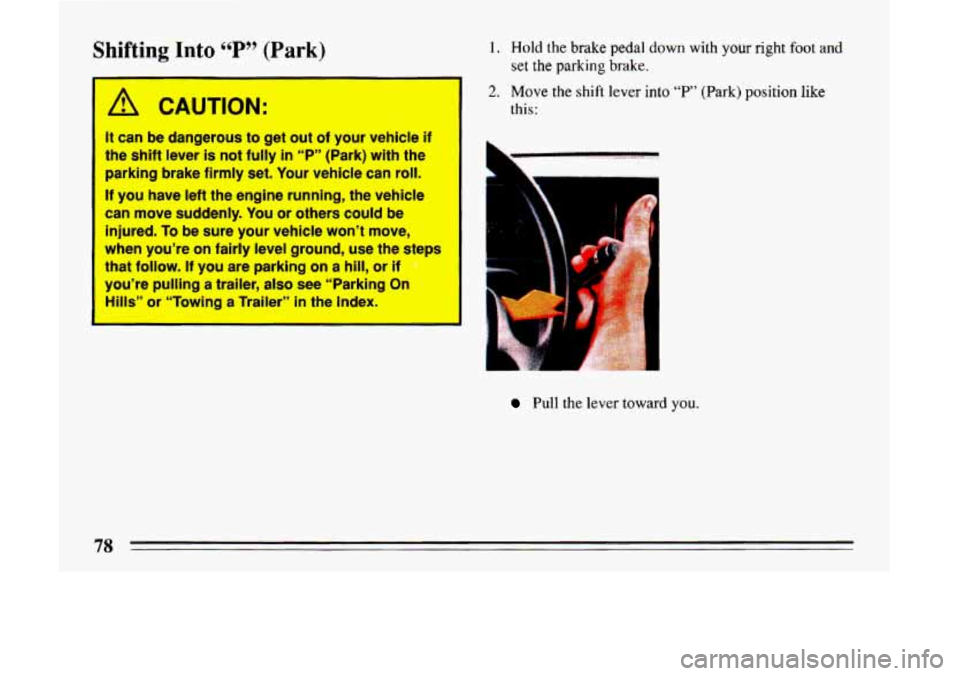
Shifting Into cc P 99 (Park)
A CAUTION:
It can be dangerous to get out of your vehicle if
the shift lever is not fully In ‘6P’’ (Park) with the
parking brake firmly set. Your vehicle
can roll.
If you have left the*engine running, the vehicle
can move suddenly.
You or others could be
injured.
To be sure your vehicle won’t move,
when you’re on fairly level ground, use the steps
that
follow. If you are parking on a hill, or if
you’re pulling
a trailer, also see “Parking On
Hills” or “Towing a Trailer” in the Index.
1
1. Hold the brake pedal down with your right foot and
2. Move the shift lever into “P” (Park) position like
set the parking brake.
this:
Pull the lever toward you.